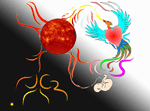« The language of truth
is simple. » Roland Barthès. |
The birth
of the healthy mind.
of the healthy mind.
3 - Social development of the child and the appearance of language :
The development of language appears, from birth, in the form that characterises the learning of the very young : imitation. Imitating means recognising the expression of the other, reproducing it, and discovering that the other reacts: the relationship can be established.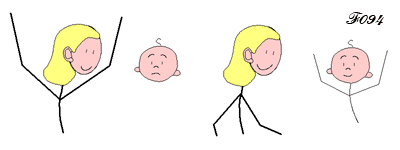
Action is a source of imitation.
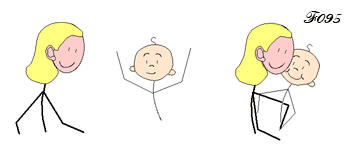
Imitation is a source of reaction : the relationship is established and develops.

Language does not do anything else.
A – Gestures, between imitation and verbal language :
It is therefore necessary, although much importance is attached to the child's language, not to forget that verbal language follows on from gesture language, and that the language of gestures and mimics is developed in the child through imitation.Thanks to these gestures, the child will learn to communicate, without however possessing language.
The same applies to animals, for example, the attitude of a cat that freezes in front of a mouse can be translated as " let's avoid attracting its attention ".
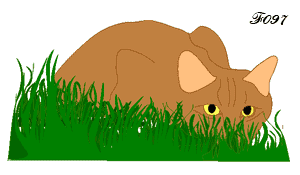
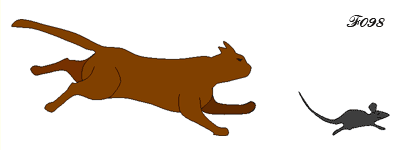
This is what human beings also do.
Everything can be said in action and silence, sound exchanges only come later. In evolved species, they result from an inhibition of action. Taking time to warn fellow creatures of a danger is to inhibit one's own flight reaction.
As for the one that has been caught by the predator, its cries and groans inform its fellow creatures of the danger they are in. Language, based on sounds, is then established.
The same is true for the suffering human being: speaking can express his inability to escape pain as well as his desire to be cured.
Is the fact that a child cannot yet express himself in words a criterion of immaturity ? Nothing of the sort !
For those who know how to observe, language is not necessary to discover the child's intelligence.
Let us return to the child. In an experiment, the team of Professor Georges Hollich (Purdue University - Indiana) showed 15-month-old babies short films showing collisions between a flower and an apple. When asked: " Where is the flower ? " They looked at it.
And when asked, " What hit the flower ? " They looked at the apple.
A sign that at this age, beyond the words designating objects, they recognise an interrogative turn of phrase and know how to answer with a simple eye movement.
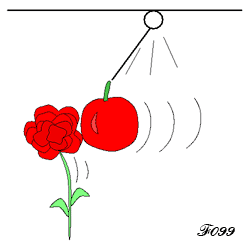
This movement is so natural that they are not even aware of it.
This reveals a lost capacity in adults: while they speak, they keep a movement that escapes their awareness, and when they listen, they no longer even think of perceiving the mimicry of the person who is speaking to them.
The adult has not only lost the awareness of his gestures, but also that of the gestures of others.
Thus, speech, by taking over from bodily expression, has led man to gradually lose awareness of his body. This phenomenon is inevitable, because attention can only be focused on one object ! [cf : le travail de la conscience - in french]
We have already mentioned this lost capacity: we are not always aware of the expression of the one who is talking to us, tired, but we are able to dream that he is tired. [cf : l'intuition - in french]
Now, all these movements are not random: although they have become non-conscious, they reflect our thoughts and our inner state of mind and they reappear in our dream imagery.
« In the adult, the gesture has become an unconscious mechanism
that reveals what the word does not express. »
that reveals what the word does not express. »
B – Gestures as a way of getting to know the other person :
This ability to accompany our words with gestures is innate: even people who are blind from birth make gestures, even though they have never seen anyone make them.Indeed, these gestures do not always help the blind speaker to be better understood, but they will express his or her inner state, even if he or she tries to hide it.
Generally speaking, while the ears hear the words, the eyes will detect the gestures, and it will be possible to grasp the meaning hidden under the words and another intention of the person who wants to influence us.
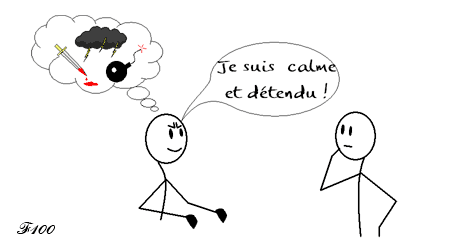
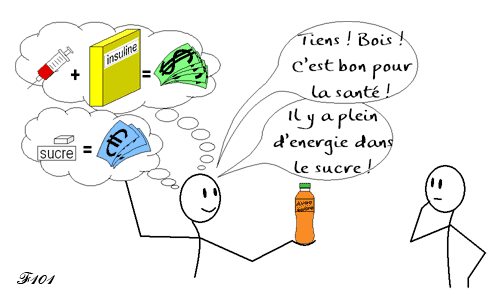
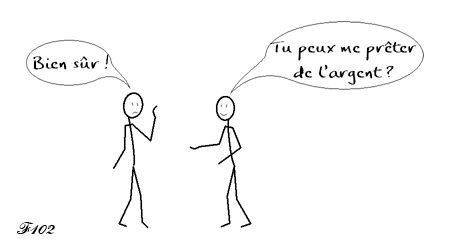
- one, developed in the course of education, which learns through the language of words,
- and the other linked to perception, to which we often no longer pay attention.
What do these gestures represent for children after their passage from the imitation stage to the communication stage ?
Researchers tell us that children's gestures indicate a different way of solving problems, often better than words.
For example, one of the most common gestures used by toddlers is pointing. And when he combines this gesture with a word, he says more than with the word alone.
For example, if he points to a hat and says "Daddy", he thinks of "Daddy's hat" or "Daddy has put on his hat": soon he will combine the words and say his first sentence.
This is how we can see that, only two or three months after his first word-gesture combination, the child will pronounce his first two-word association.
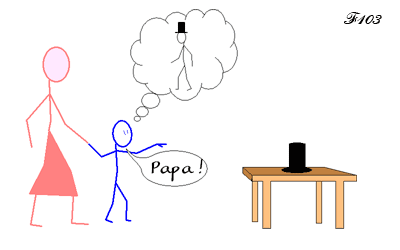
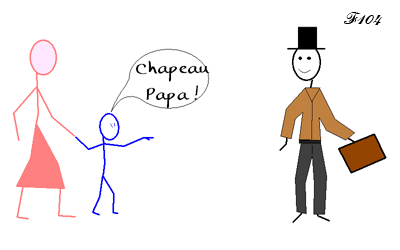
In adulthood, the development of verbal language and adherence to social rules will be at the expense of sign language, which was the visible expression of emotions.
Didn't the child learn that certain gestures were not recommended, such as pointing at someone ?
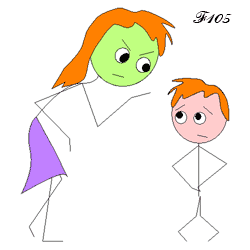
« In the child, gesture is a means of expressing
what they cannot yet say. »
what they cannot yet say. »
Could we not then establish a link with what happens during the night dream ?
The gestural language remains in the dream. The images make us experience situations where gestures alone determine the action.
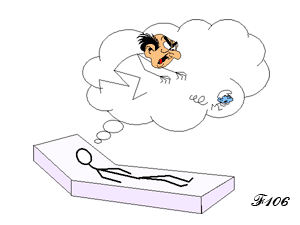
When we looked at the evolution of animal lineages, we saw that REM sleep existed in animals before the appearance of their language [cf : fonctions du rêve - in french].
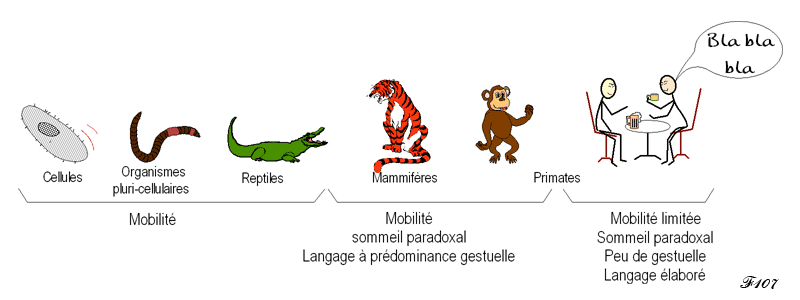
We find this chronology in the development of the child who acts before knowing how to speak to explain his gestures.
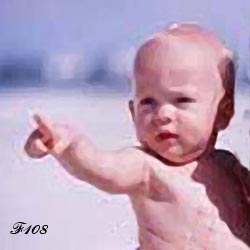
As for the adult who will gradually lose awareness of the meaning of his gestures, it is natural that he no longer knows how to translate them when they occur in his dreams.
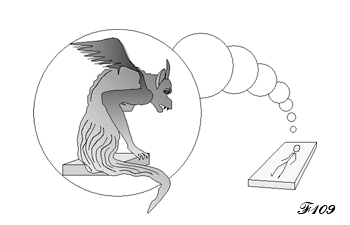 |
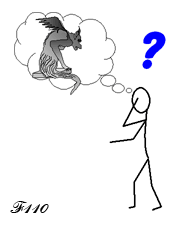 |
« Dreams ? A language of emotions and a language of gestures. »
C – The transition from gesture to speech :
Let us return for a moment to the transition from gesture to speech in the child.Is the fact that the child does not yet know how to express himself correctly in words a sign of an inability to understand ?
Can we not learn more from his or her gestures ?
We have already seen that the direction of the child's gaze on the flower and the apple indicates that the child understands the questions asked.
In another experiment, researchers from the Chicago psychology team asked kindergarteners to explain how to mentally put two parts of a shape together to find the right answer from among four proposed solutions.
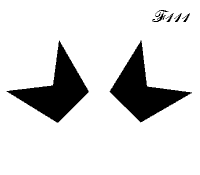 |
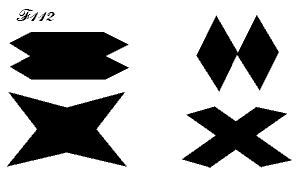 |
How to put these two shapes together... |
...to get one of these results ? |
The researchers then found that the children's hand gestures perfectly described how to move the separate elements so that they fit together correctly, although the explanations given were not always relevant (for example, some children mentioned the number of points on these shapes).

These gestures showed that their intelligence was already present to find a solution.
It is the same for the animal which must first of all determine what body strategy to adopt to catch a prey, escape a predator or extract its food from an inaccessible place.
https://www.youtube.com/watch?v=uo_mH93sIVo
In this way, the child demonstrates that the action, and the information it conveys, is prior to the vocal transmission of that information.
Later, thanks to verbal language, he will access a new possibility and learn to coordinate two complementary functions: the gesture that enables him to solve a problem, and the word that describes it. Neither can replace the other, even if gesture remains the most effective way of dealing with reality.
It thus appears that the baby is aware of the world, and also knows the way in which it should be approached.
« The child's gesture ? A way of visualising and explaining. »
D – Importance of gestures in the evolution of the child :
These gestures, so important for the child who discovers and learns, also allow the researcher and the pedagogue to discover his or her abilities and to develop them.In learning to speak, the indications given to the child by the teacher or researcher seem useful when the child is already showing, through his or her gestures, that he or she has implicit knowledge. When the child makes a mistake, correcting the gesture while explaining the error will encourage learning. It has been found that gestures always promote memorization.
In a 2007 study by Sara Broaders (Northwestern University) and Susan Wagner Cook (University of Iowa), it was shown that gestures not only reflect children's thoughts and skills, but can change and often improve their thinking.
On the other hand, while children's gestures are more effective than speech in taking action, they can also reveal faulty strategies when it comes to performing abstract work, such as arithmetic. For example, in the following research, children are asked to find the missing number in the second part of the equation 3+2+5=...+5. The child may then point to the number 10, which is incorrect, but their actions show that they have noticed the number 5 on either side of the equality.
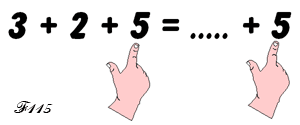
If the teacher explains the mistake in words alone, the child understands, but may make another mistake.
But if the teacher explains the error by making the gesture of linking the 3 and the 2 to place them on the right, the child understands better and memorises more easily. Gestures therefore take precedence over words, and help the child to integrate information.
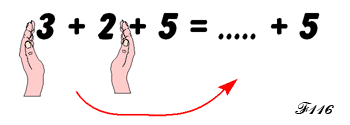
In another calculation experiment, the children were initially left to their own devices. Then the researchers asked the children to move their hands and the others to use only words to explain their answers. Then, after explaining to the children how to solve the problem, they were given identical problems to solve: the children who had made gestures got more correct answers than the others.
Allowing children to express themselves through the gestures they know and use instinctively when they speak will therefore accelerate learning. Conversely, inhibiting gestures may slow down their development...
Allowing children to express themselves through the gestures they know and use instinctively when they speak will therefore accelerate learning. Conversely, inhibiting gestures may slow down their development...
The gestures that the child naturally makes not only reflect implicit knowledge, but also help the child to bring it to the surface.
Hence the interest of an education that reinforces the link between spontaneous gesture and speech. Ensuring the coherence of the two is the most effective way to help the child progress.
Susan Wagner Cook has also taught children to make equalities by practising a gesture strategy.
Researchers have found (in 2008) that asking children to make specific gestures adapted to the exercise (and not spontaneous gestures) helps them memorise what they are learning.
Once again, we find the need for coherence in education : correcting spontaneous gestures to match speech improves thinking.
« Using gestures helps the child to integrate information. »
E – Learning gestures in society - The importance of coherence between gestures and language :
Thus, language needs bodily expression to facilitate the child's acquisition of knowledge.But, for this to happen, there must be no contradiction between the newly acquired speech and the gestures inscribed in the genetic heritage. The likely consequence would be a waste of energy, as we have seen in the case of lying. le mensonge - in french.
We have seen previously [cf : langage et détournement du souvenir - in french] that biased questions can be misleading. For example, in an accident, the more the words suggest a high degree of violence, the more the respondent believes that the speed of the vehicles was high during the collision.
It is therefore easy for an adult to lead the child to perceive something other than reality.
The child is pre-programmed to discover and learn. But he can learn from those around him the true as well as the false, whether the latter is involuntary or voluntary.
Words are misleading, but gestures are just as capable.
For example, researchers observed a teacher whose unintentional gestures led students to use the wrong strategy to solve a maths problem.
Similarly, by asking children about a character they had seen and what clothes he was wearing, Sara Broaders (Northwestern University) and Susan Goldin-Meadow (professor of psychology at the University of Chicago) were able to mislead children by making a gesture that suggested a hat.
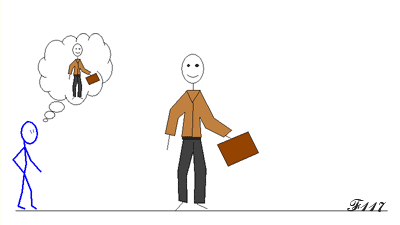 |
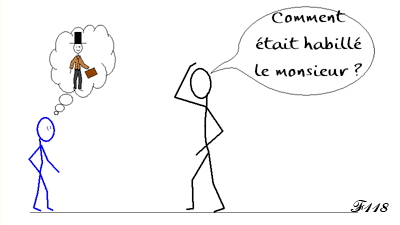 |
Observed information is often more reliable... |
...than collected information that can be induced. |
Gestures, which involve a brain capacity older than language to analyse and respond to situations, have become automatic. They allow the brain to interpret the speaker's words in a more primitive and objective way. In doing so, they reduce the amount of information that the modern cortex has to process, thus improving its ability to focus on other tasks.
Gestures, which are more emotionally related, supplement the information given by verbal language, by validating it or not. Verbal language, on the other hand, has the primary function of transmitting collective knowledge, which can either enhance or distort individual knowledge.
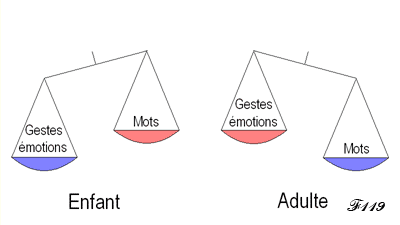 |
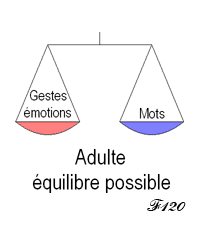 |
Si les gestes priment chez l'enfant, bientôt les mots domineront. |
The balance between the two is difficult but possible. |
«For valid information,
gestures and words cannot contradict each other. »
gestures and words cannot contradict each other. »
It is therefore from gestures that babies have been able to develop their verbal language, but gesture is not the only medium. In order to learn, the baby must also be aware of the information to be processed.
How can we detect this awareness ?
F – Verbal language :
a - Attention :In the 1990s, researchers discovered that a two- to four-day-old baby stops moving and becomes attentive when played the theme music of its mother's favourite programme heard before birth.
Furthermore, they found that within a few hours of birth, babies can differentiate between their mother tongue and a foreign language.
The foetus can therefore already recognise and retain certain characteristics of its mother tongue. The interest it shows after birth will enable researchers to detect its abilities.
« Interest in new information
is the first characteristic of consciousness. »
is the first characteristic of consciousness. »
b - The aptitude for language :
This aptitude is revealed as early as three months of age, as shown by brain imaging techniques : the areas activated in the brain of an infant who hears his mother tongue correspond to the areas of language processing in adults.
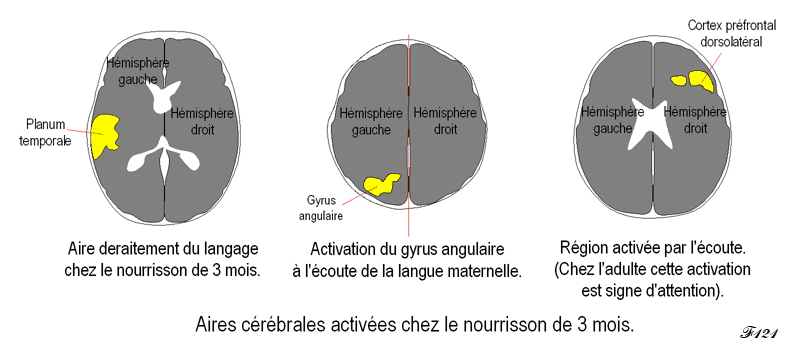
Thus, long before the baby can speak, the brain areas for language are active. They can process verbal information in much the same way as an adult, even though this language is not innate and must be learned.
This early specialisation of the regions dedicated to language appears when we look at the development of the white matter, which we know reflects the development of communication networks within the brain.
Researchers (London College University (UK) and Brown University (USA)) studied the brain structure of 108 infants and young children up to the age of 6. By observing the evolution of the distribution of white matter within the two cerebral hemispheres, they found an asymmetry between the right and left hemispheres.
However, they found that this asymmetry remains constant between the ages of 2 and 4, whereas one would expect it to increase with language development. This would mean that during this period, the environment plays a more important role than the brain organisation already in place.
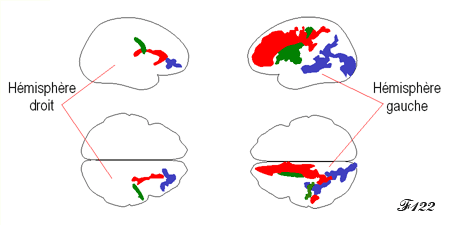
The asymmetric language brain (white matter)..
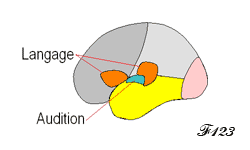 |
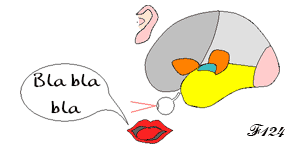 |
If the language areas are part of the acquired... |
Language depends on the environment in which the individual is immersed. |
Thus, rich in their cerebral capacities and the influence of their environment, children show themselves capable of learning to speak before the age of three and even of developing their own language [cf : pidgin].
However, even today, scientists are still wondering how children learn language.
There is no gene that causes language : it must be learned. On the other hand, the astonishing acquisition capacities of the very young and the speed with which they learn to speak, without any specific training, simply by being immersed in the world of the adult's words, indicate a genetic predisposition to this learning. This predisposition goes back a long way in the evolution of species : it already appears in the recognition of sounds that will enable individuals to communicate to inform themselves of danger or the presence of food. Once again, this recognition begins with the recognition of gestures, and is completed by that of the sounds that accompany them.
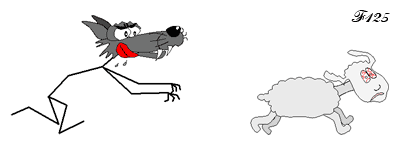
Recognition of gestures.
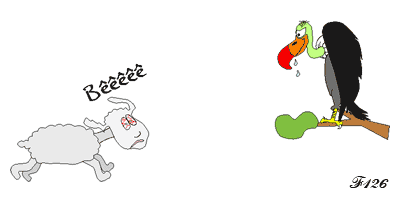
Recognition of sounds.
c - The organization of language :
1 - Discrimination of sounds :
Experiments based on babies' behavioural responses have shown that they have much more extensive language skills than previously thought, such as distinguishing their mother tongue from an unknown language. They are also sensitive to prosody, i.e. the intonation, accentuation and rhythm of the language.
To map the brain structures involved in language, researchers have long used the method of evoked potentials, which makes it possible to record the brain's electrical activity using a net fitted with electrodes covering the baby's skull.
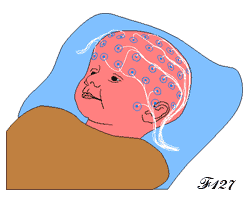
Ils ont ainsi pu montrer qu’il existe déjà, dans le cerveau du nourrisson, une organisation en réseaux neuronaux spécialisés pour le traitement linguistique. Toutefois, ces enregistrements par EEG ne permettaient pas d’obtenir des résultats très détaillés.
A first French study using f.M.R.I to explore the brain of infants was conducted at the Necker Hospital - Enfants malades in Paris, by neurobiologist Stanislas Dehaene and neuroradiologist Lucie Hertz-Pannier.
These researchers had the baby listen alternately to a story in direct reading and in reverse reading; they were then able to highlight the regions that were activated during the processing of the mother tongue (direct reading).
The interest of this method lies in the fact that the sound sequences delivered have identical acoustic parameters (frequency, intensity, etc.). If the baby's brain reacts differently, it is because, in one case, it hears its mother tongue, in the other, it is confronted with a foreign language.
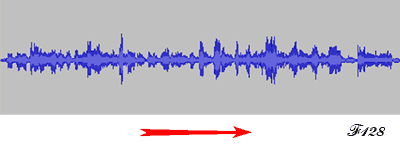
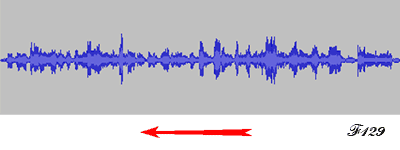
The new research not only confirms the predominance of the left hemisphere of the brain in language processing in babies, but also confirms an early memory of the mother tongue.
For example, the researchers found that the angular gyrus, which is involved in word memory, is more activated by upright speech. This suggests that the child has already developed a rough vocabulary when listening to its mother. Similarly, another area, located in the prefrontal cortex, the seat of executive functions, is activated by right-side up speech, but only in awake children. This frontal activation suggests the existence of attention mechanisms in infants, which involve immature brain regions.
This ability to discriminate sounds means that, from birth, the infant's brain recognises regularities in language, i.e. the repetition of syllables.
For example, at only two or four days of age, an infant will react differently to "penana" than to "penaku", the first word containing the repetition of the second syllable, while the second contains three distinct syllables.
The word containing two identical and contiguous syllables (penana) does not activate the same areas of the brain as the word with different (penaku), or similar, but separate syllables within the word (e.g. "penape")
Jacques Mehler, a researcher at the International School of Advanced Studies in Trieste, Italy, and his team found greater activation in the frontal and temporal lobes for first words, regions that play an important role in the understanding and production of speech.
These experiments also show that the acquisition of words by the baby does not take place in a global way, but through the detection of syllables.
Another study by researchers at the University of Washington showed that certain brain regions in the 6-month-old infant (in the hippocampus and cerebellum) predicted language skills at one year of age.
Those who performed best on the tests at one year of age were those who had the highest density of grey and white matter in the cerebellum and hippocampus four months earlier.
If the importance of memory justifies that of the hippocampus, the importance of the cerebellum involved in motor learning could indicate the role of gestures in language acquisition.
Researchers at Stockholm University have confirmed that language comprehension is facilitated by gestures, facial expressions and lip movements that accompany the sounds produced and reinforce the meaning of words.
The vocabulary explosion :
Armed with all these abilities, babies learn very quickly. At only 12 months, he understands between 65 and 110 words.
At 18 months, the child becomes very talkative, loving to show off the extent of his vocabulary. During the second year, he will increase tenfold the number of words acquired during the first year.
At a rate of 10 new words per day, he will know about 60,000 words by the time he is an adult.
The richness of his environment plays a major role in this rapid acquisition of vocabulary: his curiosity is stimulated not only by new objects, but also by the discovery that these objects have names. Finally, he quickly grasps that the slightest of his babbles attracts a crowd around him, which will encourage him to speak.
However, during the first 18 months of his life, the baby works with the greatest discretion: the few words he uses, simple and repeated by those around him (daddy, mummy, cuddly toy), seem to indicate a laborious evolution. However, this is the moment when he builds up all his knowledge with the more complex words he hears. He listens, grasps the meaning, memorises, and then, thanks to his deductive mind, he will infer new words from those he already knows.
This is the same ability to deduce that adults use to learn new words: they can guess the meaning of an unfamiliar word used in a conversation in which all the words are known. For example, if he goes to see his doctor he will be able to deduce the unfamiliar medical term to which all his symptoms are attached. By knowing all the words except one, it is possible to understand and then memorise them.
2 - A universal grammar :
Apart from the simple acquisition of a dictionary of words evoking an object or a situation (acquisition devolved to memory), how is the child's language organised ?
Already in the 1950s, the American linguist Noam Chomsky hypothesised that babies are born with innate skills that enable them to integrate and use the grammatical rules of all languages.
Sign language is no stranger to this.


Since then, researchers have been able to verify that from the age of two, children are able to make syntactic markings to recognise that a word is a noun or a verb.
For example, they recognise a word, even an unfamiliar one, as a verb in the sentence "there's an apple that dases", or the noun in the sentence "look at the dase".
Unlike adults who struggle to learn a second language, babies learn to speak with amazing ease. They discover the meaning of words on their own, manage to combine them while respecting the syntax of their mother tongue.
Even when they make mistakes, because they have not yet learned the contracted forms of language, a child is logical. For example, he will say "the neighbour's cat".
They may even create new verbs which, although inaccurate, are grammatically correct.
3 - Foreign languages :
Do these language processing skills relate only to the mother tongue ?
Not at all. A few minutes of contact with a foreign language is enough for a four-month-old infant to notice grammatical subtleties such as the link between auxiliary verbs and verb endings. For example, it has been found that German babies taught Italian react to grammatically incorrect sentences.
Another experiment, conducted by Christine Moon (professor of psychology at Pacific Lutheran University in Tacoma - USA) and her team, has just shown that, almost from birth, babies who have been shown to have the ability to learn and memorise the elementary sounds of their mother tongue, are also able to differentiate them from another language.
To do this, the researchers set up two groups of babies: the first group was made up of American newborns, the second of Swedish infants. The particularity of these languages is that certain vowels are pronounced in an almost identical way. Only 30 hours after birth, when listening to these vowels, "the newborns showed much less interest in the vowels pronounced in their own language than in the foreign language whose sounds appealed to them more.
Thus, for the child, learning a second language in the first years of life requires no effort. Bilingualism is natural for them and has only benefits. Later on, the same learning will require more effort because the extraordinary brain plasticity that characterises infants rapidly decreases at puberty.
However, learning a language for a child is still a difficult task. Therefore, young bilinguals take longer to master a language, as they have to halve the time spent learning. It is only at the age of 5-6 years that they will be able to master both languages perfectly.
In what order do these components assimilate : first the sounds, then the vocabulary, and finally the syntax which defines the combinations of words to produce sentences.
Indeed, one might assume that children should know words and their meanings in order to be able to put them together in sentences.
This is not the case. On the contrary, the syntax of sentences seems to help them retain words. This was shown in a study by an American researcher: blind children have the same lexical development as other children. Although they have not experienced sight, they know the difference between "look" and "see" at the same time as others.
For this, blind children use the syntax of words to find their way around, thus compensating for their functional deficiencies.
d - The transition from visual language to verbal language :
How is the transition made between gesture language perceived visually and verbal language perceived by hearing ?
A sentence is always associated with an image (e.g. a still apple, or a swinging apple). This means that visual syntax is at the origin of the understanding of verbal syntax, which translates it while keeping the same structure.


Nevertheless, for language to be assimilated in the best conditions, it is necessary that the description of situations given to the baby, and that he discovers, respects the same grammatical rules (for example, in French, the subject-verb-complement succession). However, these rules are diverse because of the multiplicity of languages and their grammars, which often have opposing rules. Thus, the subject of the sentence may, depending on the language, or even in the same language, be located at the beginning or end of the sentence.
For example, the sentence "A cat caught a mouse" can be translated into Russian in the following ways :

It is therefore more difficult for the child to learn if the sentence is varied, even though the situation described is identical. This explains the apparent delay in language learning in children who have to assimilate languages with different grammatical constructions.
« At the origin of the understanding of verbal syntax,
is visual syntax,
that is, the way in which gestures are ordered to create language. »
is visual syntax,
that is, the way in which gestures are ordered to create language. »
4 – The child's way of thinking before the age of 4 : (continued)

